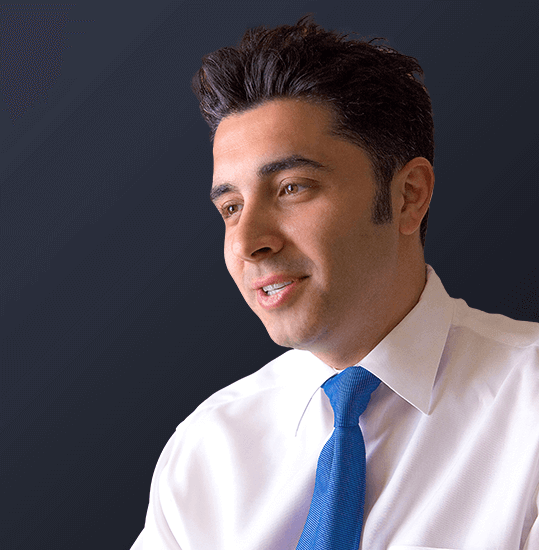California
Revocable Living TrustUnlimited attorney time
2500 +
Trusts & Wills Prepared
Free, No-Obligation Consultations

We all have an estate, no matter our net worth. If you have assets (bank accounts, real estate, etc) or responsibilities (kids, business interests, etc), our estate plans can help you avoid probate, avoid conservatorships, and protect your loved ones upon your death or incapacity.
A revocable living trust is the cornerstone of the modern estate plan. Properly drafted, a living trust offers complete asset control to clients during their lifetime. A living trust can provide for you and your loved ones in the event of incapacity. After death, a living trust allows you to pass on assets without dealing with probate costs, delays, and publicity.
Establishing a secure and legally sound financial future for you and your family can be complex. Choosing the right estate planning tools to ensure proper management, protection, and distribution of your assets may require professional legal expertise. If you’re considering a revocable living trust in California, Vaksman Khalfin can help.
Our firm has helped thousands of folks just like yourself in preparing a living trust estate plan. At this time in the process, you’re probably wondering why you need a living trust estate plan. Let me try to give you two good reasons why you should consider doing so. Honestly, it doesn’t matter if you have $500 in the bank or $500 million in the bank, a living trust estate plan is the basic foundational set of documents that anyone needs. Reason number one is to avoid probate.
Probate is a court process that if you only have a will, you don’t have a living trust in place, if you only have a will, your heirs, and your family, will necessarily have to go through probate court. It’s a court process that will take a lot of unnecessary time and cost a lot of unnecessary money and may not necessarily result in exactly what you wanted because again, it’s court, strange things happen in court and a judge has to sign off on it. That was reason number one. Reason number two is so that you can plan for your incapacity. With a simple will, you cannot plan for your incapacity. A will only have legal significance after you pass away.
Whereas a living trust, in that document you will name a successor trustee and that successor trustee will manage your assets even if you’re still alive but unable to manage your assets but you still want to benefit from your assets. That successor trustee will help you handle all of that. Don’t forget to plan for your medical incapacity. Who can make medical decisions for you when you’re unable to? We help you with that as well in the context of preparing a complete estate plan, not just a living trust. You’re probably wondering, though, why choose our firm? Again, one of the reasons is our experience, we’ve helped thousands of folks. Another reason is the value.
At the price point at which we’re offering this planning and the level of planning that we’re able to provide to you, I can assure you our level of service and our pricing is unmatched and unparalleled. In fact, our own firm used to charge four times as much as what we do today but because of our workflows, because of our automation and processes, we are able to pass on tremendous savings to you. Still have questions? Please feel free to call us at any time. Regardless of whether you are engaged or not, we are happy to answer your questions before, during, and after the representation without any additional cost or share your information in the form and we’d be happy to give you a callback and chat with you.
Robert B. Vaksman, Esq.
Founding Partner
“Some cases are easier than others, but this doesn’t matter at Vaksman Khalfin, because we have the resources to help our clients no matter what is at stake, especially if it’s hard."

Alan D. Khalfin, Esq.
Partner & Managing Attorney
"People call me when they need to plan, but also when something terrible has happened and they need help. It is personal to my clients, so it is personal to me. We have to help — no matter what."

What Is a Revocable Living Trust?
The revocable trust definition is a legal entity created by an individual, or grantor, who assigns a trustee with the authority to manage and dispose of the trust’s assets. Fundamentally, you design a revocable living trust to avoid probate and provide for estate management during incapacity without a court’s involvement.
Are you wondering how a living trust works?
A grantor transfers the assets into the trust, which operates like a real estate family trust. You can alter or revoke the trust as you see fit throughout your lifetime. Upon the grantor’s passing, a living trust works to bypass the complexities and costs of probate, ensuring a smoother transition of assets.
But how does a revocable living trust work in California?
Creating a trust in California involves identifying and documenting personal property or real estate. The grantor then assigns a trustee, and both parties sign the documentation in the presence of a notary public.
Who Needs a Living Trust?
There are a few cases where a living trust could benefit you:
- If you, as a grantor, want to bypass probate procedures.
- If you, as a grantor, want someone else to manage your property after your death.
- If you’re a grantor wanting to ensure your property continues to be managed efficiently in the case of your disability or demise.
- A living trust helps grantors who prioritize privacy in handling their estates both in life and in death.
- A living trust is favorable for grantors with a business or professional practice. This structure might be particularly advantageous to your estate planning strategy.
Setting Up a Trust in California
California Trust Requirements
Setting up a trust in California requires careful attention to state-specific regulations and requirements. California Trust Law specifies that a living trust involves the existence of the following:
- The trust must have property.
- The trust must have a grantor (also known as a settlor or trustor) responsible for transferring property into the trust and establishing its terms.
- The trust also requires a trustee assigned by the grantor. The trustee has the legal title to the property within the trust and typically oversees and dispenses its income. However, the trustee must abide by the terms outlined by the grantor.
- A beneficiary is also necessary. This individual is the party that stands to benefit from the trust and will receive direct or indirect income from the trust property. Beneficiaries in California possess certain rights, like the right to know the trust exists and the right to receive a copy of the trust.
- Both the grantor and the trustee must be legally competent. The grantor must sign the trust in front of a certified notary. Following this, the grantor should use their property to fund the trust.
Where to File a Living Trust in California
You typically won’t need to submit to any court or government body when you file a living trust in California. Instead, the grantor or the named successor trustees securely hold the documents..
Eligibility to Contest a Living Trust
If you’re a beneficiary or believe you received unfair exclusion from a trust, consult with experienced living trust lawyers to understand your rights and the necessary legal procedures.
Statute of Limitations for Contesting a Revocable Trust in California
Ensure you understand the time limitations affecting your ability to challenge a living trust. Consult with attorneys specializing in trusts for an accurate timeline.
How to Create a Living Trust in California
1. Compile an asset list.
Create a list of your assets, both physical and financial. Below are assets that should go into your trust:
- Real estate
- Banking and trading accounts
- Other high-value assets, like jewelry or artwork
Assets that shouldn’t be in your living trust:
- Vehicles, as they depreciate and are often bought and sold, making them hard to manage.
- Non-probate assets, including your life insurance and retirement accounts, like 401(k)s and IRAs.
2. Appoint a trustee.
Trustees manage trust assets. Many people name themselves as the trustee for living trusts. If you do this, ensure you list a successor trustee in your document who’ll manage your assets in the event of your death or incapacitation.
3. Identify your beneficiaries.
Your beneficiaries are entitled to the assets in your trust upon your demise. The successor trustee will ensure this process. You can choose beneficiaries for every trust asset or even designate nonprofits as beneficiaries. Ensure you record the beneficiary’s name, address, and employer identification number (EIN).
4. Prepare your Declaration of Trust.
A valid declaration needs appropriate legal language and proper execution.
You can execute a trust document by:
- Using an online platform, where numerous tools allow you to fill out and print a form.
- Hiring an estate attorney if dealing with a complex estate.
5. Notarize your trust document.
Trust validation in California requires the signing of the trust document. For document authentication, many people choose to sign it in the presence of a notary public. You can find notaries in several locations, including banks, law firms, and libraries.
6. Transfer property ownership to the trust.
After signing the trust document, entrust your property to this legal entity. You should list your trustee as the property owner on the new deed or title. Remember to transfer any new assets you acquire into your trust.
What You Can Expect
FREE CONSULTATION
Our goal is for each client to have an opportunity to secure their estate. That is why your Vaksman Khalfin journey begins with a no-obligation free confidential consultation. This free session provides an opportunity to understand your unique needs, discuss your concerns, and establish how we can assist you towards achieving your estate planning goals.
FLEXIBLE PRICING
We understand that everyone's financial situation is different. Moreover, everyone may have different estate planning needs. With this in mind, we offer flexible pricing structures to ensure our quality legal services are accessible to all. Our goal is to provide exceptional value, at a cost that makes sense for your personal circumstances.
SAFE ACCESS TO YOUR DOCUMENTS
Your estate planning documents are important and should be readily accessible when you need them. To ensure the security of these documents, we provide safe and easy access to your files at any time.
PERSONAL SUPPORT
A dedicated attorney and case manager will be assigned to your case to ensures a personal and concerted approach to your legal matter. This focused support provides a direct point of contact, personalized attention to your case, and ensures the swift resolution of any concerns or issues that may arise.
HOW IT WORKS
We'll fight for your rights.
Complimentary consultation
Complimentary phone or Zoom meeting with our law firm to answer any questions and discuss our process.
Work with a legal team
Work with us through an easy and secure process to design your custom plan.
Confirm and sign your documents
We draft your plan for your review. Once confirmed, we’ll provide you a binder with final documents for you to sign.
When is a Revocable Living Trust Funded?
Funding refers to the act of transferring assets into the trust.
You typically fund a trust by moving the asset title from your name to the trust’s name. The conditions of the trust dictate how to manage the moved assets.
Here’s how to maintain funding for a revocable living trust:
- When you create the trust, it should have a detailed schedule that determines complete funding. This schedule outlines the asset address, Access Point Name (APN) for real estate, and a list of bank accounts with their associated account numbers.
- Every year after funding, review your assets to ensure the trust holds each intended one.
- Be sure to update beneficiary designations for assets outside the trust.
The funding process for a revocable living trust can occur upon trust creation or at any later point. Commonly prompted with a token upon trust creation, a power of attorney holder can also fund the trust, assuming granted powers permit them to.
In some situations, courts have given power of attorney holders the authority to transfer assets into trusts even without explicit authorization. Still, we don’t recommend relying on this.
It’s also critical to update all relevant beneficiary designations during the funding process to align with the trust’s provisions.
Steps to Fund Your Living Trust
Although you may think that your Estate Planning is complete after you have set up your Living Trust, there is still one more very important step: funding. If you create a Living Trust but do not fund it, your Trust is essentially worthless as an Estate Planning tool.
Once you have had your questions answered about how to create a Living Trust and you have taken the steps to establish the Trust, it is time to fund the Trust so you can accomplish the goals you have set for your Estate Plan. Funding the Trust simply means transferring your assets to the Trust. While that seems simple enough, the documents needed for funding your Living Trust will vary, depending on the asset type.
Any asset you fail to transfer to the Trust will not be owned by the Trust and, therefore, will have to go through Probate after you die (unless that asset has a beneficiary designation or is owned jointly with someone). Therefore, funding is not an option, but a requirement. You must transfer ownership of your assets to the Trust while you are living.
1. Naming Your Trust
The documents created to establish your Living Trust will contain a statement that establishes the formal, legal name of the Trust. That formal name will designate how you refer to the Trust when you name it on certificates of title, deeds, documents assigning an interest in assets, or a beneficiary designation. Having the Trust documents in place, complete with a formal name, is an essential first step to funding the Trust.
2. Transferring Different Types of Assets to the Trust
Real Property
Typically the simplest way to transfer real property to a Living Trust is by using a quit claim deed (though other types of deeds such as warranty deeds or special warranty deeds may also be used). You have to ensure that the deed is properly executed and recorded, according to the standards of the state where the property is located. It may also be necessary to file or record Trust documents or a Trust summary document (referred to as a Certificate of Trust or a Memorandum of Trust). If you own the property subject to a mortgage, it is likely the mortgage contract requires you to obtain permission from the lending bank to transfer the property to the Trust. However, some mortgage contracts now specifically do not require prior permission for a transfer to a Revocable Living Trust, where you are the initial Trustee.
Transferring the property may trigger a transfer tax, so be sure to check the requirements in your state. Your state may have a law that exempts the transfer to a Trust from the transfer tax or it may treat the transfer as a full-value sale. Be sure to determine if the tax will be owed and plan for that additional expense.
Personal Property With Title Documents
If your personal property ownership is recorded on a title document, you will have to request a new title to be issued that reflects your Living Trust as an owner. Common examples of these types of property include vehicles such as trucks, cars, motorcycles, RVs, and motorcycles. Many states allow you to designate your Living Trust as the beneficiary on your current motor vehicle title, in which case, the vehicle remains titled in your name and transfers ownership to the Trust upon your death. The Department of Motor Vehicles has simple, one-page forms for this purpose.
Personal Property Without Title Documents
Most of the personal property you own does not have a title document reflecting ownership. Such items include your clothes, jewelry, furniture, collectibles, and other personal effects. The ownership of these items may be easily transferred to your Living Trust by utilizing an assignment of ownership document. The document must be signed and dated and indicate your intent to transfer ownership of the items to the Living Trust. Your Estate Plan should include this document.
Bank Accounts
Check with your bank to determine what specific forms they need to be completed in order to transfer your checking, savings, or other bank accounts to your Trust. In rare situations, you may need to close your personal accounts and open new accounts in the name of your Living Trust.
Securities
Transferring your brokerage account or other investment accounts should be a relatively simple process to transfer ownership, similar to bank accounts. Work closely with your brokerage or financial adviser to determine what documents are required to fund your financial accounts, including stocks, bonds or other financial instruments.
Life Insurance Beneficiaries
Life insurance policies will allow you to designate your beneficiaries. In most cases, you can consider not naming your Living Trust as the beneficiary, but simply designating the primary and contingent people directly. However, in some situations, it may make sense to name your Living Trust as the beneficiary of the Life Insurance policy. Speak to an attorney to determine what is appropriate for you.
Retirement Accounts
Retirement accounts, just like insurance policies, will allow you to designate your beneficiaries. In most cases, you can consider designating the primary and contingent people directly, instead of the naming the Living Trust as the beneficiary. However, if your retirement assets are large, you may want to consider a separate IRA Trust to be the beneficiary. Speak to an attorney to determine what makes sense for your situation.
Accounts Receivable
In order to designate the Living Trust as the rightful recipient of any and all payments made on loans that are owed to you, you can utilize an assignment of rights document to legally declare the Living Trust as the entity with the rights to the debt.
Summary to Funding Your Living Trust
If you transfer your various assets to your Trust, the Living Trust can help you to keep your assets safe from the Probate process and ensure your family and loved ones are cared for. This Estate Planning tool is affordable, effective, and can be done privately to keep your family’s information private. Additionally, a Living Trust can easily be used to manage a large number of assets, of varying type, even if they are located in several different states. By transferring ownership of your assets to your Living Trust you eliminate the need for your family to navigate the costly and confusing Probate process.

How Is a Revocable Living Trust Taxed in California?
Understanding the tax implications of a revocable living trust is essential. Consult with California trust attorneys for advice tailored to your specific circumstances.
Here are some general considerations:
- Under federal tax law, a revocable living trust’s income is taxed directly to the grantor using their tax rate because the grantor is viewed as the trustee’s assets owner. (IRC Sec. 671)
- Neither making nor funding a revocable living trust results in a gift tax, as the gift isn’t complete until the trust is irrevocable. (Burnet v. Guggenheim, 288 U.S.280 (1933))
- Since the grantor hasn’t irrevocably disposed of any assets, the whole trust corpus is included in the grantor’s estate for federal estate tax purposes. (IRC Sec. 2038)
Benefits of a Living Trust
Comparing a living trust to a will can help you understand its benefits. A will is a testamentary instrument only effective upon your death. A living trust takes effect once you sign it and transfer assets. Both documents direct how to distribute your assets upon your death. Yet, a living trust also conducts management of your assets during life. That’s why your successor trustee can continue managing your assets without court intervention or supervision with a properly funded living trust.
Your trust agreement outlines how and who can determine if you’re incompetent. Your agreement should also explain how to manage financial affairs, which the successor trustee must follow. Be aware that the successor trustee only deals with finances. A successor trustee doesn’t have the power to make your healthcare decisions. Even with a revocable living trust, you still need a will, specifically, a Pour-Over Will, that passes anything you own at death to the trust.
By transferring your assets to your living trust, you maintain control of them while you’re alive. You also remove them from the probate process after your death. All your investments pass according to the instructions in your living trust. Although an administration process is still necessary, it doesn’t involve the time, expense, and publicity of probate court intervention.
A revocable living trust also provides flexibility, enabling you to control the distribution of your assets to loved ones or charity after your death. You might also avoid a second estate tax, if the investments pass on to your grandchildren after your child passes. At Vaksman Khalfin, you can provide as much latitude to your children as you like. We specialize in drafting the terms of your trust per your wishes.
Do You Need a Will and Trust Attorney?
While not everyone needs a living trust attorney, professional legal assistance has several benefits.
Will and trust lawyers are versed in all facets of estate planning and can craft a solid plan that accounts for your current needs and future goals. These attorneys have the knowledge and expertise to advise you on the most effective ways to protect your assets, minimize estate taxes, and ensure a smooth transition of your property and belongings to your loved ones. Will and trust lawyers acknowledge the relevant state laws to ensure your will and trust are legally untouchable.
California trust attorneys provide vital support in navigating the complex legal and emotional terrain of estate planning. They guide you through determining how to distribute your assets, helping to avoid family disputes, and ensuring accurate reflection of your wishes. A will and trust attorney can also assist in setting up guardians for minor children, trusts for disabled dependents, and other specific provisions tailored to your needs and circumstances.
Hiring a will and trust attorney offers you peace of mind. Estate planning can be fraught with pitfalls for the uninformed. Errors in documentation or non-compliance with legal requirements can invalidate a will or trust, leading to unintended consequences. An attorney can draft all documents correctly following current laws and reducing the risk of contests and disputes. Seeking an attorney ensures you leave your possessions in the right hands and honor your final wishes.
Schedule a Free Consultation with Vaksman Khalfin Living Trust Attorneys Today
Our team of experienced living trust attorneys at Vaksman Khalfin is here to assist you in protecting your estate. We have years of professional knowledge, a profound understanding of estate law, and a respectful, empathetic approach to these often delicate matters.
Scheduling a consultation with Vaksman Khalfin living trust attorneys is your first step to peace of mind. We offer comprehensive services to guide you through every step, laying out every option to cater to your needs. Our commitment is unparalleled, and we pride ourselves on our track record, earning the trust of countless clients in the process. So don’t wait another day to start planning for your future. Contact Vaksman Khalfin today, and let’s guarantee your legacy lives on just as you intend.
WHAT OUR CLIENTS SAY
California Revocable Living Trust
Frequently Asked Questions
You’ll need a will and trust attorney to set up a living trust in California., We recommend someone specialized in estate planning, like our experienced California trust attorneys at Vaksman Khalfin.
Yes, you can amend your living trust without an attorney. Still, legal assistance ensures adherence to California trust requirements.
The cost of creating a trust can vary depending on the complexities involved. It’s best to consult with an attorney for an accurate estimate. Schedule a free, no-obligation consultation with a California trust attorney at Vaksman Khalfin. We can help you figure out your particular needs and the costs involved.
To create a trust in California, you must document the assets involved, appoint a trustee, and sign the document before a notary public. While it sounds simple, there are many nuances in the process. Vaksman Khalfin lawyers are here to help you each step of the way.
It typically takes about 12-18 months to settle a living trust in California, depending on complexities and potential contests.
No, you don't have to record a living trust in California. But, the grantor or successor trustees must keep the documents secure.
No, you don’t have to file a living trust with the courts in California.
California can rule a living trust invalid if it’s fraudulent, has undue influence, or the grantor was incompetent at the time of creation.
Yes, someone can sue against a living trust in California. But, the trust assets are generally well-protected.
No, one of the top benefits of a living trust in California is that it avoids probate.
An improperly drafted trust or one with unclear terms might go to probate.
After someone dies, the successor trustee typically manages the trust as per the deceased's outlined wishes.
Although you can create a trust without a will, having both can ensure a comprehensive estate plan and cover all possible contingencies.
Under the Rule of Perpetuities, a house can stay in a trust for a maximum of 21 years after death. However, this law is seldomly applicable to most trusts. In California, timeframe often varies depending on trust guidelines.
Primary beneficiaries (or residuary beneficiaries) will inherit all of your assets minus your specific gifts. Contingent beneficiaries will inherit your assets if all of your primary beneficiaries predecease you.
At Vaksman Khalfin, we always refer to unborn children if you decide to distribute your assets to your children equally. Future children will automatically be included as equal beneficiaries, so you won't need to update the trust for this purpose. Still, it's beneficial to include an amendment to list new children in the ‘family information’ section of the trust.
When you create a living trust, you must first write and sign the living trust document. Then transfer ownership of your assets to your trust by changing title to the asset. This second step is called funding, and prevents your assets from going through probate. Failure to fund your living trust results in non-trust assets going through probate.
Setting up a Living Trust will not affect the way you file your income tax returns. The IRS and state tax authorities essentially disregard a living trust, and you continue filing your return using your social security number. Titling your real property in the name of your Trust will also not trigger a reassessment of property taxes. The transfer to a revocable trust is seen as a transfer to yourself (since your trust will continue to use your SSN for tax purposes), thereby not triggering a reassessment of property taxes.
A trust transfer deed is the instrument that effectuates the transfer of ownership of your real-estate from you, as an individual, to your trust. The process of creating and then recording a trust transfer deed is how your property becomes a trust asset (thereby avoiding probate, among other benefits).
SUBMIT YOUR CONTACT DETAILS 100% Free Consultation, Always. Free Consultation.







